District 01S Division 11 Flotilla 02


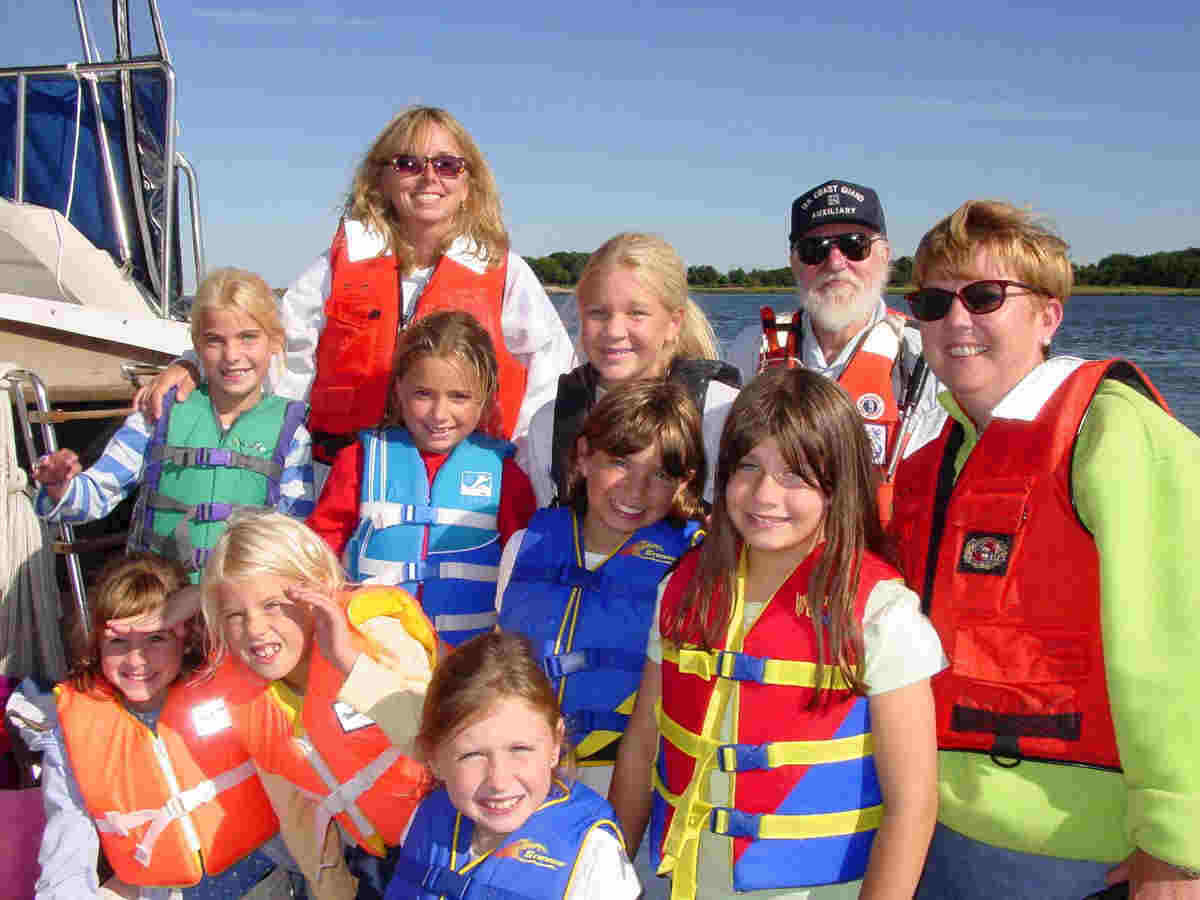
Life Jackets (PFD's*)
* Personal Floatation Device
Types of
jackets
Choosing and Using the Correct PFD - click here
Floatation properties
Children
Consider carrying these items too
notice:6/22
1. The U.S. Coast Guard has become aware of a potential problem with
installation of CO2 cylinders that have bayonet tips in inflatable
personal
flotation devices (PFDs or life jackets). If a cylinder is not properly
installed, the PFD will not inflate with CO2. The problem may affect several
thousand PFDs, but the Coast Guard is only aware of one incident to date.
The following link to the USCG Boating web site provides detailed
information: http://www.uscgboating.org/alerts/alertsview.aspx?id=50
[[Inflatable PFD Mysteries Exposed - http://auxbdept.org/pdf/InflatablePFDs.pdf ]]
Why Should I Wear My Life Jacket?
The U.S. Coast Guard estimates that life jackets could have saved the lives of over 80 percent of boating fatality victims.
As a boat operator, you're in command of the safety of your passengers. But accidents can, and do happen with terrifying speed on the water. There's rarely time to reach stowed life jackets.
The U.S. Coast Guard challenges you and your passengers to wear your life jacket all the time while underway.
New Life Jackets are attractive and easy to wear.
It’s tempting to boat without wearing a life jacket – especially on nice
days. But modern life jackets are available in a wide variety of shapes, colors,
and sizes. Many are thin and flexible. Some are built right into fishing vests
or hunter coats. Others are inflatable — as compact as a scarf or fanny pack
until they hit water, when they automatically fill with air.
CAUTION:
PFDs are NOT baby-sitters!
A parent should always be alert when the child is on or near the water. Parents,
remember too, inflatable toys, surf rafts and other non-approved devices are not
dependable and should NEVER be used in place of PFDs.
top
Things to know:
Some situations that you want to be protected in:
![]()
TYPES OF PERSONAL FLOTATION DEVICES (PFDs) -
Descriptions
top
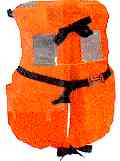 |
A TYPE I PFD, or OFFSHORE LIFE JACKET provides the most buoyancy. It is effective for all waters, especially open, rough, or remote waters where rescue may be delayed. It is designed to turn most unconscious wearers in the water to a face-up position. The TYPE I comes in two sizes: Adult size provides at least 22 pounds of buoyancy, the child size, 11 pounds, minimum. |
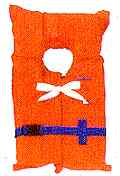 |
A TYPE II PFD, NEAR-SHORE BUOYANT VEST is intended for calm, inland water or where there is a good chance of quick rescue. This type will turn some unconscious wearers to a face-up position. The turning action is not as pronounced nor as effective as a TYPE I. An adult size provides at least 15.5 pounds buoyancy, a medium child size provides 11 pounds. Infant and small child sizes each provide at least 7 pounds buoyancy. |
 |
A TYPE III PFD, or FLOTATION AID is good for calm, inland water, or where there is a good chance of quick rescue. It is designed so that wearers can put themselves in a face-up position in the water. The wearer may have to tilt their head back to avoid turning face down. TYPE III has the same minimum buoyancy as a TYPE II PFD. Float coats, fishing vests, and vests designed for various water sports are examples. |
 |
A TYPE IV PFD, or THROWABLE DEVICE is intended for calm, inland water with heavy boat traffic, where help is always present. It is designed to be thrown to a person in the water and grasped and held by the user until rescued. It is not designed to be worn. Type IV devices include buoyant cushions, ring buoys, and horseshoe buoys. |
 |
A TYPE V PFD, or SPECIAL USE DEVICE is intended for specific activities and may be carried instead of another PFD only if used according to the approval condition on the label. Some Type V devices provide hypothermia protection. Varieties include deck suits, work vests, board sailing vests, and Hybrid PFDs. A TYPE V HYBRID INFLATABLE PFD is the least bulky. It contains a small amount of inherent buoyancy and an inflatable chamber and must be worn when underway to be acceptable. |
Recommended Items to equip a life Jacket With
 A
USCG approved Safety Whistle (A whistle with A cork ball is no good when wet)
A
USCG approved Safety Whistle (A whistle with A cork ball is no good when wet)
 A USCG approved Strobe light (Must be waterproof)
A USCG approved Strobe light (Must be waterproof)
 A Mirror used to single another boat or Aircraft, In case of a emergency you can
use the reflective side of a compact disk.
A Mirror used to single another boat or Aircraft, In case of a emergency you can
use the reflective side of a compact disk.
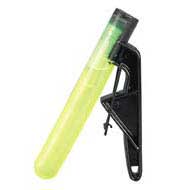 Cyalume ® Personal Marker Light (Can last 8-12hrs when activated)
Cyalume ® Personal Marker Light (Can last 8-12hrs when activated)
 A Knife - has many purposes. One is ability to cut lines (rope) or clothes in
emergencies.
A Knife - has many purposes. One is ability to cut lines (rope) or clothes in
emergencies.
 VHF Marine radio, as well as
AM band - good to have in case of electrical power
failure or radio failure or loss of vessel
VHF Marine radio, as well as
AM band - good to have in case of electrical power
failure or radio failure or loss of vessel
![]()
|
There are three basic kinds of PFD flotation in the five types of PFDs with the following characteristics: Inherently Buoyant (primarily Foam)
|
||||||||||||||||||||
--------------------------------------------------------------------------------------
|
||||||||||||||||||||
-------------------------------------------------------------------------------------
|
||||||||||||||||||||
|
||||||||||||||||||||
_________________________________________________________________________________________
* Inflatable PFDs
Child PFD Requirements
Some states require that children wear PFDs
Check with your state boating safety officials.
Child PFD approvals are based on the child's weight.
Check the "User Weight" on the label, or the approval
statement that will read something like "Approved for use on recreational
boats and uninspected commercial vessels not carrying passengers for hire, by
persons weighing __ lbs".
They can be marked "less than 30", "30 to 50", "less
than 50", or "50 to 90".
![]()
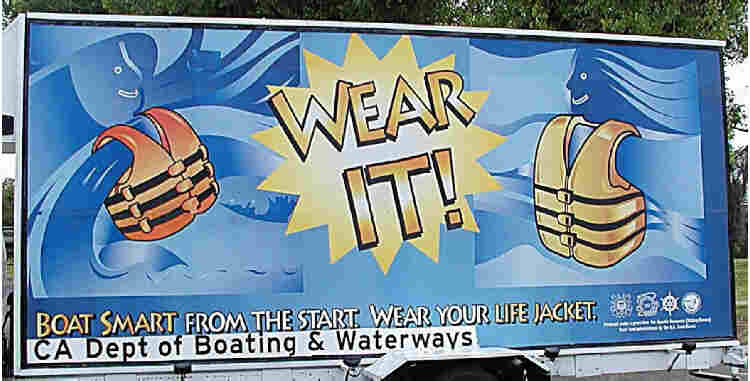
** Disclaimer: Any recommendations are not considered to be exhaustive in nature. Please take a boating safety course to supplement the material found on the web pages.
1. See story of General Slocum - a boat disaster that happened in NYC in the early 20th century.
Parts of this page are derived from Jay Gellman's work and from www.Boatsafe.com. We wish to thank them.